
© Caruntu Group; Central Michigan University 2019








Cupidatat voluptate
Ut adipisicing, in cillum cupidatat voluptate esse.
Veniam proident ut veniam adipisicing fugiat sunt in
enim ullamco mollit irure deserunt ullamco eu enim
anim. Est, quis, et ea, incididunt ut non incididunt amet
enim, aliquip consectetur sit.
$0.00









Figure 1. Variable sized/shaped monodisperse magnetic and ferroelectric nanocrystals obtained by our group

Research
1. Colloidal Synthesis of Metal Oxide Nanoparticles and Assemblies The synthesis of metal oxide nanoparticles with controlled morphology and their assemblies into
The synthesis of metal oxide nanoparticles with controlled morphology and their assemblies into ordered structures is one of the main research themes in our group. A particular focus has been put in
ordered structures is one of the main research themes in our group. A particular focus has been put in developing new methodologies in both aqueous and non-aqueous media for the preparation of transition
developing new methodologies in both aqueous and non-aqueous media for the preparation of transition metal ferrite and perovskite-type colloidal nanocrystals. By achieving control over the size and shape of
metal ferrite and perovskite-type colloidal nanocrystals. By achieving control over the size and shape of these nano-objects, a long term objective of this research topic is to assemble them into highly organized
these nano-objects, a long term objective of this research topic is to assemble them into highly organized superlattice structures and superparticles and study their properties for potential technological
superlattice structures and superparticles and study their properties for potential technological applications.
applications.
 The synthesis of metal oxide nanoparticles with controlled morphology and their assemblies into
The synthesis of metal oxide nanoparticles with controlled morphology and their assemblies into ordered structures is one of the main research themes in our group. A particular focus has been put in
ordered structures is one of the main research themes in our group. A particular focus has been put in developing new methodologies in both aqueous and non-aqueous media for the preparation of transition
developing new methodologies in both aqueous and non-aqueous media for the preparation of transition metal ferrite and perovskite-type colloidal nanocrystals. By achieving control over the size and shape of
metal ferrite and perovskite-type colloidal nanocrystals. By achieving control over the size and shape of these nano-objects, a long term objective of this research topic is to assemble them into highly organized
these nano-objects, a long term objective of this research topic is to assemble them into highly organized superlattice structures and superparticles and study their properties for potential technological
superlattice structures and superparticles and study their properties for potential technological applications.
applications.
2. Metal Oxide Nanotubes and Nanowires Mono-dimensional oxide nanostructures, such as iron oxides, spinels MFe2O4 and perovskites ABO3
Mono-dimensional oxide nanostructures, such as iron oxides, spinels MFe2O4 and perovskites ABO3 are synthesized in aqueous solutions by a soft-solution approach. Metal oxide nanotubes and nanowires
are synthesized in aqueous solutions by a soft-solution approach. Metal oxide nanotubes and nanowires with tunable length, wall thickness and diameter are prepared by combining a template method with a
with tunable length, wall thickness and diameter are prepared by combining a template method with a solution-mediated approach. Highly uniform nanotubes are formed within the pores of a porous
solution-mediated approach. Highly uniform nanotubes are formed within the pores of a porous membranes through capillary effects as a result of a hydrolysis reaction. This methodology is cost effective,
membranes through capillary effects as a result of a hydrolysis reaction. This methodology is cost effective, simple and environmetally friendly (deposition temperatures are as low as 45 oC). Metal oxide nanotubes
simple and environmetally friendly (deposition temperatures are as low as 45 oC). Metal oxide nanotubes are subsequently filled with a second metal or metal oxide phase, thereby generating nanotube-nanowire
are subsequently filled with a second metal or metal oxide phase, thereby generating nanotube-nanowire ordered arrays. These nanostructures are being used as templates for the fabrication of hierarchical 1-D
ordered arrays. These nanostructures are being used as templates for the fabrication of hierarchical 1-D core-shell nanoarchitectures and also integrated into magnetoelectric devices or used for the
core-shell nanoarchitectures and also integrated into magnetoelectric devices or used for the photochemical splitting of water molecules.
photochemical splitting of water molecules.
 Mono-dimensional oxide nanostructures, such as iron oxides, spinels MFe2O4 and perovskites ABO3
Mono-dimensional oxide nanostructures, such as iron oxides, spinels MFe2O4 and perovskites ABO3 are synthesized in aqueous solutions by a soft-solution approach. Metal oxide nanotubes and nanowires
are synthesized in aqueous solutions by a soft-solution approach. Metal oxide nanotubes and nanowires with tunable length, wall thickness and diameter are prepared by combining a template method with a
with tunable length, wall thickness and diameter are prepared by combining a template method with a solution-mediated approach. Highly uniform nanotubes are formed within the pores of a porous
solution-mediated approach. Highly uniform nanotubes are formed within the pores of a porous membranes through capillary effects as a result of a hydrolysis reaction. This methodology is cost effective,
membranes through capillary effects as a result of a hydrolysis reaction. This methodology is cost effective, simple and environmetally friendly (deposition temperatures are as low as 45 oC). Metal oxide nanotubes
simple and environmetally friendly (deposition temperatures are as low as 45 oC). Metal oxide nanotubes are subsequently filled with a second metal or metal oxide phase, thereby generating nanotube-nanowire
are subsequently filled with a second metal or metal oxide phase, thereby generating nanotube-nanowire ordered arrays. These nanostructures are being used as templates for the fabrication of hierarchical 1-D
ordered arrays. These nanostructures are being used as templates for the fabrication of hierarchical 1-D core-shell nanoarchitectures and also integrated into magnetoelectric devices or used for the
core-shell nanoarchitectures and also integrated into magnetoelectric devices or used for the photochemical splitting of water molecules.
photochemical splitting of water molecules.
2. Metal Oxide Nanotubes and Nanowires









Figure 2. Nanotube and nanowire arrays of perovskites and spinel ferrites obtained by a template-assisted route

3. Thin Film and Multilayer Metal Oxide Structures Another targeted area of interest involves the chemical deposition of high quality thin films and
Another targeted area of interest involves the chemical deposition of high quality thin films and multilayered structures. Our research on thin film structures is a key prerequisite for the development of
multilayered structures. Our research on thin film structures is a key prerequisite for the development of new functional materials and devices. Recent research efforts have been focused on the soft solution
new functional materials and devices. Recent research efforts have been focused on the soft solution processing of ferroelectric and magnetic metal oxide thin films with controllable morphology and
processing of ferroelectric and magnetic metal oxide thin films with controllable morphology and predictable properties. These films are furthermore used for the design of complex architectures such as
predictable properties. These films are furthermore used for the design of complex architectures such as multicomponent metal oxide films with graded composition and magnetoelectric multilayers.
multicomponent metal oxide films with graded composition and magnetoelectric multilayers.
 Another targeted area of interest involves the chemical deposition of high quality thin films and
Another targeted area of interest involves the chemical deposition of high quality thin films and multilayered structures. Our research on thin film structures is a key prerequisite for the development of
multilayered structures. Our research on thin film structures is a key prerequisite for the development of new functional materials and devices. Recent research efforts have been focused on the soft solution
new functional materials and devices. Recent research efforts have been focused on the soft solution processing of ferroelectric and magnetic metal oxide thin films with controllable morphology and
processing of ferroelectric and magnetic metal oxide thin films with controllable morphology and predictable properties. These films are furthermore used for the design of complex architectures such as
predictable properties. These films are furthermore used for the design of complex architectures such as multicomponent metal oxide films with graded composition and magnetoelectric multilayers.
multicomponent metal oxide films with graded composition and magnetoelectric multilayers.
.








Figure 3. Magnetic and ferroelectric granular thin films and bilayered structures obtained at 45oC

4. Scanning Probe Microscopy An important component of our research is dedicated to the study of the polar ordering and the local
An important component of our research is dedicated to the study of the polar ordering and the local properties of nnaoscale ferroic materials. To this end, scanning probe microscopy (SPM) and piezoresponse
properties of nnaoscale ferroic materials. To this end, scanning probe microscopy (SPM) and piezoresponse force microscopy (PFM) are components of germane importance in our experimental toolbox for the
force microscopy (PFM) are components of germane importance in our experimental toolbox for the characterization of the electromechanical response of ferroelectric and magnetoelectric materials. While most
characterization of the electromechanical response of ferroelectric and magnetoelectric materials. While most scanning probe microscopy techniques are used in the study of the converse magnetoelectric effect (changes
scanning probe microscopy techniques are used in the study of the converse magnetoelectric effect (changes in the magnetic structure induced by an electric field), we have developed recently a technique for the
in the magnetic structure induced by an electric field), we have developed recently a technique for the qualitative and quantitative evalauation of the magnetoelectric coupling in nanocomposites by measuring the
qualitative and quantitative evalauation of the magnetoelectric coupling in nanocomposites by measuring the piezoelectric response of the material in a magnetic field. This method is simple, easy to use and interpret and
piezoelectric response of the material in a magnetic field. This method is simple, easy to use and interpret and allows for the precise estimation of the local magnetoelctric coupling in nanocomposites with various types of
allows for the precise estimation of the local magnetoelctric coupling in nanocomposites with various types of connectivity schemes between the magnetic and the electrostrictive phases at nanoscale.
connectivity schemes between the magnetic and the electrostrictive phases at nanoscale.
 An important component of our research is dedicated to the study of the polar ordering and the local
An important component of our research is dedicated to the study of the polar ordering and the local properties of nnaoscale ferroic materials. To this end, scanning probe microscopy (SPM) and piezoresponse
properties of nnaoscale ferroic materials. To this end, scanning probe microscopy (SPM) and piezoresponse force microscopy (PFM) are components of germane importance in our experimental toolbox for the
force microscopy (PFM) are components of germane importance in our experimental toolbox for the characterization of the electromechanical response of ferroelectric and magnetoelectric materials. While most
characterization of the electromechanical response of ferroelectric and magnetoelectric materials. While most scanning probe microscopy techniques are used in the study of the converse magnetoelectric effect (changes
scanning probe microscopy techniques are used in the study of the converse magnetoelectric effect (changes in the magnetic structure induced by an electric field), we have developed recently a technique for the
in the magnetic structure induced by an electric field), we have developed recently a technique for the qualitative and quantitative evalauation of the magnetoelectric coupling in nanocomposites by measuring the
qualitative and quantitative evalauation of the magnetoelectric coupling in nanocomposites by measuring the piezoelectric response of the material in a magnetic field. This method is simple, easy to use and interpret and
piezoelectric response of the material in a magnetic field. This method is simple, easy to use and interpret and allows for the precise estimation of the local magnetoelctric coupling in nanocomposites with various types of
allows for the precise estimation of the local magnetoelctric coupling in nanocomposites with various types of connectivity schemes between the magnetic and the electrostrictive phases at nanoscale.
connectivity schemes between the magnetic and the electrostrictive phases at nanoscale.
Figure 4. AFM topography and PFM phase contrast images of a PbTiO3-Terfenol-D bilayered
nanocomposite in the presence of different magnetic fields (H=-2000, 0 and +2000 Oe)




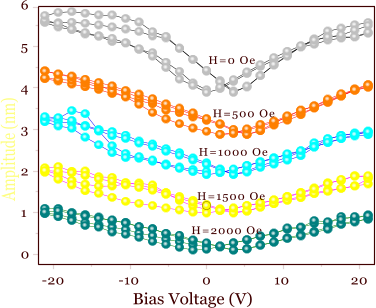
-20
-10
0
10
20
-50
0
50
100
150
200
250


























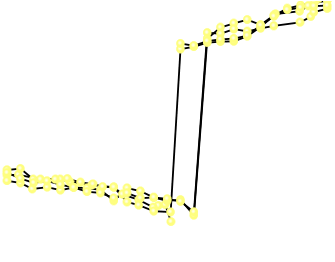
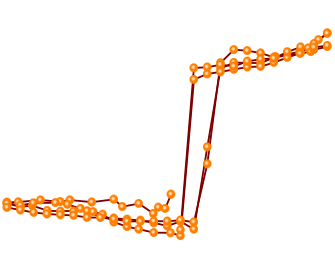
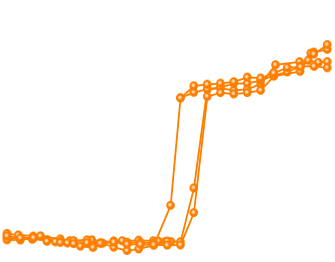
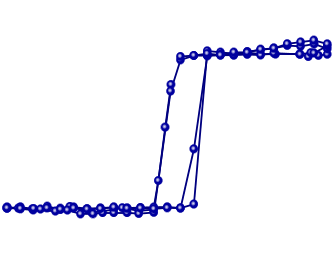
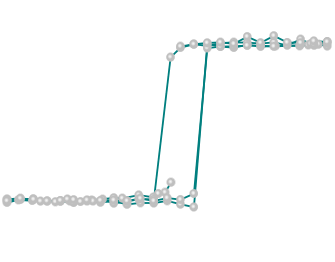





H=0 Oe





H=500 Oe





H=1000 Oe





H=1500 Oe





H=2000 Oe


Bias Voltage (V)
Figure 5. Phase and amplitude plots of the piezoresponse of a PbTiO3-Terfenol-D bilayered
nanocomposite in the presence of different magnetic fields
Our research is at the crossroads of synthetic chemistry, materials science, engineering and nanotechnology being aimed at the design of nanomaterials with precisely controled composition,
nanotechnology being aimed at the design of nanomaterials with precisely controled composition, microstructure and surface reactivity. We are particularly interested in the study of ferroic properties
microstructure and surface reactivity. We are particularly interested in the study of ferroic properties (ferroelectricity and magnetism) of low-dimensional systems, as well as the intimate coupling between
(ferroelectricity and magnetism) of low-dimensional systems, as well as the intimate coupling between these phenomena. To this end, we developed soft-solution chemical routes to produce ferroic and
these phenomena. To this end, we developed soft-solution chemical routes to produce ferroic and magnetoelectric multiferroic materials with various topological features (colloidal nanocrystals,
magnetoelectric multiferroic materials with various topological features (colloidal nanocrystals, nanotubes and nanorods and thin films) which can be used in different applications, ranging from energy
nanotubes and nanorods and thin films) which can be used in different applications, ranging from energy stoage/conversion and drug delivery to catalysis, sensing and cellular imaging.
stoage/conversion and drug delivery to catalysis, sensing and cellular imaging.
 nanotechnology being aimed at the design of nanomaterials with precisely controled composition,
nanotechnology being aimed at the design of nanomaterials with precisely controled composition, microstructure and surface reactivity. We are particularly interested in the study of ferroic properties
microstructure and surface reactivity. We are particularly interested in the study of ferroic properties (ferroelectricity and magnetism) of low-dimensional systems, as well as the intimate coupling between
(ferroelectricity and magnetism) of low-dimensional systems, as well as the intimate coupling between these phenomena. To this end, we developed soft-solution chemical routes to produce ferroic and
these phenomena. To this end, we developed soft-solution chemical routes to produce ferroic and magnetoelectric multiferroic materials with various topological features (colloidal nanocrystals,
magnetoelectric multiferroic materials with various topological features (colloidal nanocrystals, nanotubes and nanorods and thin films) which can be used in different applications, ranging from energy
nanotubes and nanorods and thin films) which can be used in different applications, ranging from energy stoage/conversion and drug delivery to catalysis, sensing and cellular imaging.
stoage/conversion and drug delivery to catalysis, sensing and cellular imaging.

CARUNTU Research Group
Nanostructured Materials For Energy Applications







